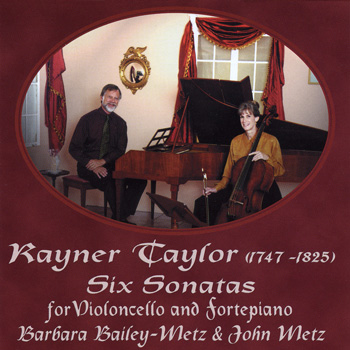Rayner Taylor arrived in Philadelphia in 1792, having abandoned the important post of Music Director at the prestigious Sadler's Wells Theatre in London. Why, at the age of 45, this successful musician decided to undertake new adventures in a new land, we don't know--except that Philadelphia was the capital of the new nation and the hub of musical life in Federalist America. Taylor may have been summoned there by any one of the many accomplished English musicians already working in that city.
In the course of a long and productive life, Rayner Taylor composed a grand opera, The AEthiop, and he published many hundreds of songs and sacred anthems as well as instrumental music. Not everything was published: there remained "shelves groaning under manuscript files of overtures, operas, anthems, glees &c." The Six Sonatas for Cello are among these unpublished works and until recently have remained on tn shelves' of the Library of Congress, largely neglected, bound wil volume of published cello sonatas by J. G. C. Schetky (1795).
We don't know when Taylor composed the cello sonata was perhaps at the same time as his six sonatas for violin and published in London in 1781. The Library of Congress score do( to be the original manuscript, but a copy, made by the compose evidently in haste given the number of obvious scribal errors. Wi know when or for whom he prepared this copy, except that it mL been after he immigrated to America. Examination of the watem suggests that the paper on which it was written was made by Jo mill in Chambersburg, Pennsylvania, sometime between 1790 a We may then imagine that they were copied for one of the excel known to have come to Philadelphia, perhaps for a performance the many private salon recitals held there.
Rayner Taylor was born somewhere in or near London He was trained as a choirboy in the Chapel Royal and in that cal at Handel's funeral. At the ceremony, his hat fell into the grave buried with the Master, prompting someone to comment, "Neve left you some of his brains in return!' In England, Taylor had enj enviable reputation as composer, singer, organist, and Music Di Sadler's Wells; in Philadelphia, he held several church organ positions, taught, composed, copied music for sale, and he was often a featured performer at the various pleasure gardens in the city. As compo singer, and teacher, Taylor won the admiration of Philadalphianc 1820, he helped found the Musical Fund Society and became it's "Director of Music.' Taylor died on August 17, 1825. His gravestone (now destroyed) read, "In memory of Raynor Taylor, a distinguished Professor of Music, and many years Organist of St. Perter's church, who died August 17th 1825 in the 78th year of his age. This tribute of respect is erected by the Musical Fund Society of Philadelphia."
Taylor's compositional style is early classical, with rondos, short sonata forms, and dance movements with variations. An important aspect making these sonatas unique in the cello repertoire is Taylor's use of the solo instrument. Whereas contemporaries like Graziani and Boocherini Nere pushing the cello up into the violin range, Taylor preferred to explore he naturally resonant bass and tenor tessitura. In places, the cello writing seems to ask the pianist to become an equal partner even though the, Syboard part is only a sketch -just a basso continuo line and figures. bus the pianist has to provide a fairly ambitious realization, keeping in mind Taylor's reputation as an improviser 'equal to the great C.P.E. Bach.' Until now these sonatas have not been recorded, except as part f as a limited circulation archival LP series issued by The Society for the reservation of the American Musical, Heritage, Inc. The recording, made in e 1960's, was based on an unpublished arrangement of the sonatas, ads for the project by Le Roy Robinson. By contrast, we have used period struments and the Library of Congress manuscript for the present CD cording. We offer this recording as a companion to the edition we have prepared for publication by Recent Researches (A-R Editions) with the intention of bringing these interesting and beautiful pieces back to life in our own time.
- John Metz and Barbara Bailey-Metz
In the course of a long and productive life, Rayner Taylor composed a grand opera, The AEthiop, and he published many hundreds of songs and sacred anthems as well as instrumental music. Not everything was published: there remained "shelves groaning under manuscript files of overtures, operas, anthems, glees &c." The Six Sonatas for Cello are among these unpublished works and until recently have remained on tn shelves' of the Library of Congress, largely neglected, bound wil volume of published cello sonatas by J. G. C. Schetky (1795).
We don't know when Taylor composed the cello sonata was perhaps at the same time as his six sonatas for violin and published in London in 1781. The Library of Congress score do( to be the original manuscript, but a copy, made by the compose evidently in haste given the number of obvious scribal errors. Wi know when or for whom he prepared this copy, except that it mL been after he immigrated to America. Examination of the watem suggests that the paper on which it was written was made by Jo mill in Chambersburg, Pennsylvania, sometime between 1790 a We may then imagine that they were copied for one of the excel known to have come to Philadelphia, perhaps for a performance the many private salon recitals held there.
Rayner Taylor was born somewhere in or near London He was trained as a choirboy in the Chapel Royal and in that cal at Handel's funeral. At the ceremony, his hat fell into the grave buried with the Master, prompting someone to comment, "Neve left you some of his brains in return!' In England, Taylor had enj enviable reputation as composer, singer, organist, and Music Di Sadler's Wells; in Philadelphia, he held several church organ positions, taught, composed, copied music for sale, and he was often a featured performer at the various pleasure gardens in the city. As compo singer, and teacher, Taylor won the admiration of Philadalphianc 1820, he helped found the Musical Fund Society and became it's "Director of Music.' Taylor died on August 17, 1825. His gravestone (now destroyed) read, "In memory of Raynor Taylor, a distinguished Professor of Music, and many years Organist of St. Perter's church, who died August 17th 1825 in the 78th year of his age. This tribute of respect is erected by the Musical Fund Society of Philadelphia."
Taylor's compositional style is early classical, with rondos, short sonata forms, and dance movements with variations. An important aspect making these sonatas unique in the cello repertoire is Taylor's use of the solo instrument. Whereas contemporaries like Graziani and Boocherini Nere pushing the cello up into the violin range, Taylor preferred to explore he naturally resonant bass and tenor tessitura. In places, the cello writing seems to ask the pianist to become an equal partner even though the, Syboard part is only a sketch -just a basso continuo line and figures. bus the pianist has to provide a fairly ambitious realization, keeping in mind Taylor's reputation as an improviser 'equal to the great C.P.E. Bach.' Until now these sonatas have not been recorded, except as part f as a limited circulation archival LP series issued by The Society for the reservation of the American Musical, Heritage, Inc. The recording, made in e 1960's, was based on an unpublished arrangement of the sonatas, ads for the project by Le Roy Robinson. By contrast, we have used period struments and the Library of Congress manuscript for the present CD cording. We offer this recording as a companion to the edition we have prepared for publication by Recent Researches (A-R Editions) with the intention of bringing these interesting and beautiful pieces back to life in our own time.
- John Metz and Barbara Bailey-Metz




